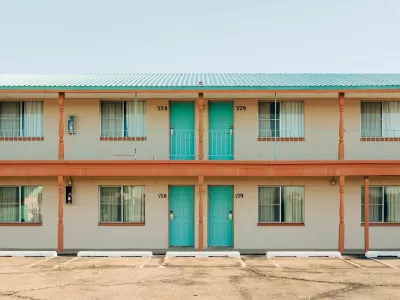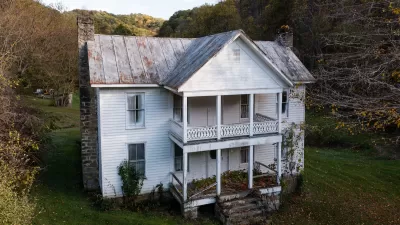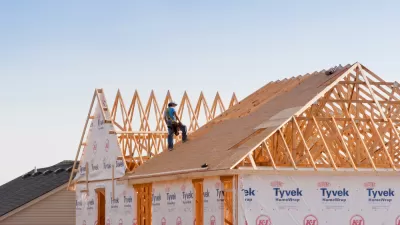Many guests at Motels4Now are on their second or third stays—but staff say that's doesn't equal failure, and the numbers bear that out.

Afternoons at Motels4Now are rarely boring.
In the parking lot outside a former Knights Inn in South Bend, Indiana, a young woman and an older man are engaged in a bitter argument. At times, the back-and-forth calms, only to loudly reconvene in one of the rooms or behind the building. The young woman, Clara (residents’ real names won’t be used here), issues a series of colorful, detailed threats and defies anyone to stop her from carrying them out. “I heard the cops are coming!” she yells. “Where are they? I ain’t afraid!”
Soon after, a city police officer does drive up, but by then Clara has left. The police officer pulls away, ignoring a young man riding his bicycle in tiny circles in the middle of the parking lot and a woman who emerges from one of the rooms every few minutes to levy rapid-fire accusations to no one in particular. A heavily bearded man takes it all in from his spot in a stained beige recliner next to thedumpster, drinking from a 25-ounce can of Hurricane High Gravity malt liquor, a small pile of empties at his feet.
Another man hurriedly walking across the parking lot is greeted by Motels4Now director Sheila McCarthy, who welcomes him back after a short jail stint for violating his probation as a sex offender. McCarthy returns to the staff office, two motel rooms with the separating wall knocked out. A diagram on the wall notes the risk levels of injecting drugs into different areas of the body. Desperation can trump discretion, though: one of the residents was recently treated for a large injection-created abscess in her neck.
Motels4Now is a low-barrier shelter, meaning that residents do not have to demonstrate sobriety or medication compliance to be able to stay. The staff estimates that nearly all of the 115 residents are dealing with at least one severe mental illness, often including addiction. About 80 percent have lived on the streets for a year or more, and few are able to consistently keep any employment besides occasional one-off jobs. More than half of the current residents are on their second stay here, usually because they have been asked to leave during previous stays, usually after repeated unauthorized visitors or conflicts with other residents.
The challenges are on high-volume display, but McCarthy points out some less obvious signs of success. A group of older men sit and talk in chairs they have set up on the narrow sidewalk in front of their rooms. Among them is Lawrence, who lived outdoors for 18 years before being invited to move to Motels4Now. There was an adjustment period—Lawrence at first did not want to spend the night indoors, and then he struggled to break his habit of hoarding food for weeks on end. But now he is settling in, regularly getting medical care for the first time in four decades, and enjoying the security of a locked door to protect him at night. “It is a myth that people prefer to be homeless if they have an alternative that allows them safety and respect,” McCarthy says.
Motel4Now’s most impressive success stories are no longer on site. A full three-quarters of former residents, 400 people in total, now live in stable long-term housing. Those who have not yet joined them are on the same path, McCarthy insists, even while dealing with profound challenges exacerbated by years on the streets. She points to the office wall opposite the safe injection poster where a print made by a local artist reads “Housing is Healing.” “You can see when our repeat guests come back, they are a little better each time,” McCarthy says. “It is visibly transformative for them to have a roof over their heads.”
McCarthy picks an unlikely example: Clara, the young woman who was just threatening a fellow resident. Overall, Clara’s stay was much more peaceful than her past times at Motels4Now, McCarthy says. Like all the others who have been asked to leave, Clara will be assured that she is automatically on the waiting list for a return stay, and she will be welcomed back when her name gets to the top of that list.
FULL STORY: FULL STORY

Planetizen Federal Action Tracker
A weekly monitor of how Trump’s orders and actions are impacting planners and planning in America.

Chicago’s Ghost Rails
Just beneath the surface of the modern city lie the remnants of its expansive early 20th-century streetcar system.

San Antonio and Austin are Fusing Into one Massive Megaregion
The region spanning the two central Texas cities is growing fast, posing challenges for local infrastructure and water supplies.

Since Zion's Shuttles Went Electric “The Smog is Gone”
Visitors to Zion National Park can enjoy the canyon via the nation’s first fully electric park shuttle system.

Trump Distributing DOT Safety Funds at 1/10 Rate of Biden
Funds for Safe Streets and other transportation safety and equity programs are being held up by administrative reviews and conflicts with the Trump administration’s priorities.

German Cities Subsidize Taxis for Women Amid Wave of Violence
Free or low-cost taxi rides can help women navigate cities more safely, but critics say the programs don't address the root causes of violence against women.
Urban Design for Planners 1: Software Tools
This six-course series explores essential urban design concepts using open source software and equips planners with the tools they need to participate fully in the urban design process.
Planning for Universal Design
Learn the tools for implementing Universal Design in planning regulations.
planning NEXT
Appalachian Highlands Housing Partners
Mpact (founded as Rail~Volution)
City of Camden Redevelopment Agency
City of Astoria
City of Portland
City of Laramie





























